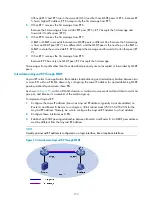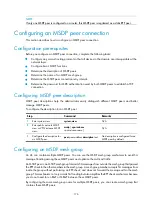
169
Figure 50
Where MSDP peers are in the network
As shown in
, an MSDP peer can be created on any PIM-SM router. MSDP peers created on
PIM-SM routers, that assume different roles, will function differently.
1.
MSDP peers on RPs include the following types:
{
Source-side MSDP peer
—The MSDP peer nearest to the multicast source (Source), typically the
source-side RP, like RP 1. The source-side RP creates SA messages and sends the messages to its
remote MSDP peer to notify the MSDP peer of the locally registered multicast source information.
A source-side MSDP peer must be created on the source-side RP. Otherwise, it cannot advertise
the multicast source information out of the PIM-SM domain.
{
Receiver-side MSDP peer
—The MSDP peer nearest to the receivers, typically the receiver-side RP,
like RP 3. After receiving an SA message, the receiver-side MSDP peer resolves the multicast
source information carried in the message and joins the SPT rooted at the source across the
PIM-SM domain. When multicast data from the multicast source arrives, the receiver-side MSDP
peer forwards the data to the receivers along the RPT.
{
Intermediate MSDP peer
—An MSDP peer with multicast remote MSDP peers, like RP 2. An
intermediate MSDP peer forwards SA messages received from one remote MSDP peer to other
remote MSDP peers, functioning as a relay of multicast source information.
2.
MSDP peers created on common PIM-SM routers (other than RPs)
Router A and Router B are MSDP peers on common multicast routers. Such MSDP peers just
forward received SA messages.
In a PIM-SM network using the BSR mechanism, the RP is dynamically elected from C-RPs.
To enhance network robustness, a PIM-SM network typically has more than one C-RP. As the RP election
result is unpredictable, MSDP peering relationships must be built among all C-RPs so that the winner C-RP
is always on the "MSDP interconnection map," and loser C-RPs assumes the role of common PIM-SM
routers on the "MSDP interconnection map."
Inter-domain multicast delivery through MSDP
As shown in
, an active source (Source) exists in the domain PIM-SM 1, and RP 1 has learned
the existence of Source through multicast source registration. If RPs in PIM-SM 2 and PIM-SM 3 also seek
the specific location of Source so that receiver hosts can receive multicast traffic that the source sends,
MSDP peering relationships must be established between RP 1 and RP 3 and between RP 3 and RP 2,
respectively.
















































